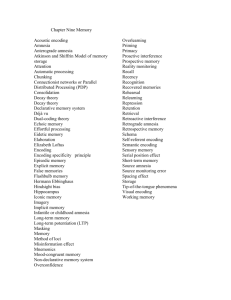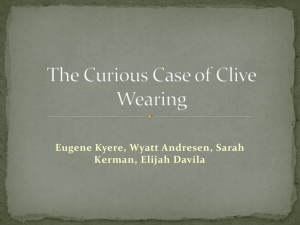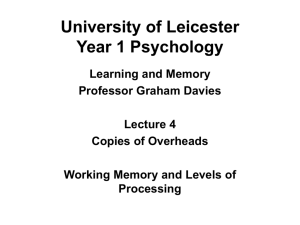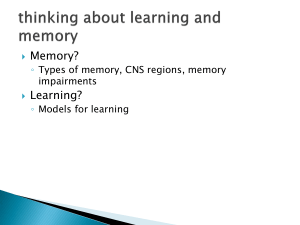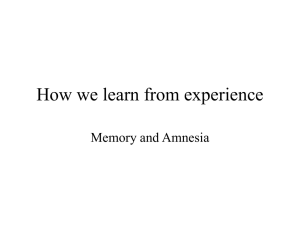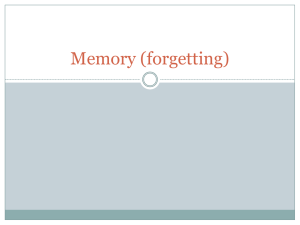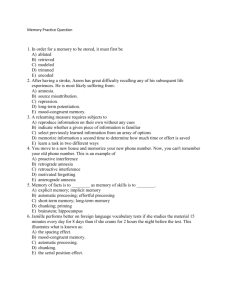Memory Chapter 8 PowerPoint
advertisement
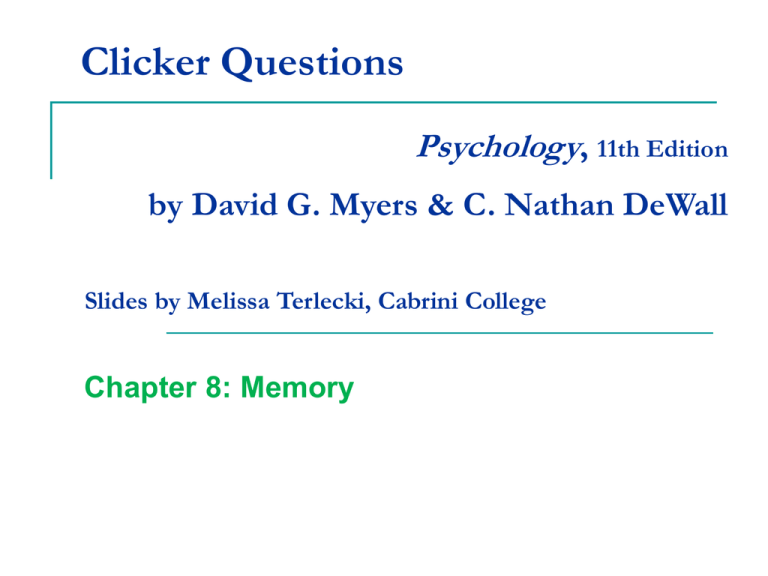
Clicker Questions Psychology, 11th Edition by David G. Myers & C. Nathan DeWall Slides by Melissa Terlecki, Cabrini College Chapter 8: Memory 1. Which refers to the processing of information into the memory system? A. B. C. D. Encoding Storage Parallel processing Retrieval 1. Which refers to the processing of information into the memory system? ANSWER A. B. C. D. Encoding Storage Parallel processing Retrieval 2. The correct order of information to travel through the memory system is: A. long-term memory short-term memory sensory memory. B. short-term memory long-term memory sensory memory. C. sensory memory short-term memory longterm memory. D. sensory memory long-term memory shortterm memory. 2. The correct order of information to travel through the memory system is: ANSWER A. long-term memory short-term memory sensory memory. B. short-term memory long-term memory sensory memory. C. sensory memory short-term memory longterm memory. D. sensory memory long-term memory shortterm memory. 3. Which of the following does NOT enhance memory? A. B. C. D. Chunking Mnemonics Distributed practice Massed practice 3. Which of the following does NOT enhance memory? ANSWER A. B. C. D. Chunking Mnemonics Distributed practice Massed practice 4. Which part of the brain is responsible for emotion-related memory formation? A. B. C. D. Basal ganglia Amygdala Hippocampus Cerebellum 4. Which part of the brain is responsible for emotion-related memory formation? ANSWER A. B. C. D. Basal ganglia Amygdala Hippocampus Cerebellum 5. The idea that cues and contexts specific to a particular memory will be effective in helping us recall it, is called (the): A. B. C. D. long-term potentiation. priming. encoding specificity principle. serial position effect. 5. The idea that cues and contexts specific to a particular memory will be effective in helping us recall it, is called (the): ANSWER A. B. C. D. long-term potentiation. priming. encoding specificity principle. serial position effect. 6. The tendency to recall items that appear first on a list is called (the): A. B. C. D. recency effect. primacy effect. mood congruency. priming. 6. The tendency to recall items that appear first on a list is called (the): ANSWER A. B. C. D. recency effect. primacy effect. mood congruency. priming. 7. The inability to form new memories is called: A. B. C. D. anterograde amnesia. proactive interference. retrograde amnesia. retroactive interference. 7. The inability to form new memories is called: ANSWER A. B. C. D. anterograde amnesia. proactive interference. retrograde amnesia. retroactive interference. 8. Misleading information that has corrupted one’s memory of an event is called (the): A. B. C. D. reconsolidation. ˏˎ deja vu. source amnesia. misinformation effect. 8. Misleading information that has corrupted one’s memory of an event is called (the): ANSWER A. B. C. D. reconsolidation. ˏˎ deja vu. source amnesia. misinformation effect. 9. Misattributing whether we heard about, read about, or imagined an event is called: A. B. C. D. retrograde amnesia. source amnesia. anterograde amnesia. infantile amnesia. 9. Misattributing whether we heard about, read about, or imagined an event is called: ANSWER A. B. C. D. retrograde amnesia. source amnesia. anterograde amnesia. infantile amnesia. 10. Research shows which of the following does NOT improve memory? A. B. C. D. Sleep Rehearsal Testing Interference 10. Research shows which of the following does NOT improve memory? ANSWER A. B. C. D. Sleep Rehearsal Testing Interference Critical Thinking Questions 11. Max is unfamiliar with the timelines he needs to remember for his history class, and he is disinterested in the material. Which of the following will memorization likely require? A. B. C. D. Implicit memory Automatic processing Effortful processing Procedural memory 11. Max is unfamiliar with the timelines he needs to remember for his history class, and he is disinterested in the material. Which of the following will memorization likely require? ANSWER A. B. C. D. Implicit memory Automatic processing Effortful processing Procedural memory 12. If Alana is picturing the words on this slide as she reads them for a fraction of a second (before they fade away), she is likely utilizing (the): A. B. C. D. iconic memory. central executive. echoic memory. chunking. 12. If Alana is picturing the words on this slide as she reads them for a fraction of a second (before they fade away), she is likely utilizing (the): ANSWER A. B. C. D. iconic memory. central executive. echoic memory. chunking. 13. Vera needs to memorize a new route to work because of a road closure. Instead of memorizing the number of turns and stoplights, she thinks about her favorite stores that she passes on her way. This would be an example of (the): A. B. C. D. testing effect. shallow processing. automatic processing. deep processing. 13. Vera needs to memorize a new route to work because of a road closure. Instead of memorizing the number of turns and stoplights, she thinks about her favorite stores that she passes on her way. This would be an example of (the): ANSWER A. B. C. D. testing effect. shallow processing. automatic processing. deep processing. 14. Leonard can remember exactly where he was and how he felt the day his grandmother died; the weather, the time, what activities he was engaged in. Recalling it in such detail makes him feel upset. This is an example of (a/an): A. B. C. D. flashbulb memory. long-term potentiation. implicit memory. memory consolidation. 14. Leonard can remember exactly where he was and how he felt the day his grandmother died; the weather, the time, what activities he was engaged in. Recalling it in such detail makes him feel upset. This is an example of (a/an): ANSWER A. B. C. D. flashbulb memory. long-term potentiation. implicit memory. memory consolidation. 15. Charity is having trouble remembering the layout of her new dorm room this year because the location of appliances is on the opposite side of the room. Almost by habit, she walks to the wrong side of the room to use them. This is an example of: A. B. C. D. encoding failure. proactive interference. retrograde amnesia. repression. 15. Charity is having trouble remembering the layout of her new dorm room this year because the location of appliances is on the opposite side of the room. Almost by habit, she walks to the wrong side of the room to use them. This is an example of: ANSWER A. B. C. D. encoding failure. proactive interference. retrograde amnesia. repression.


